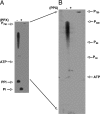Polyphosphate kinase 1, a conserved bacterial enzyme, in a eukaryote, Dictyostelium discoideum, with a role in cytokinesis
- PMID: 17940044
- PMCID: PMC2034253
- DOI: 10.1073/pnas.0706847104
Polyphosphate kinase 1, a conserved bacterial enzyme, in a eukaryote, Dictyostelium discoideum, with a role in cytokinesis
Abstract
Polyphosphate kinase 1 (PPK1), the principal enzyme responsible for reversible synthesis of polyphosphate (poly P) from the terminal phosphate of ATP, is highly conserved in bacteria and archaea. Dictyostelium discoideum, a social slime mold, is one of a few eukaryotes known to possess a PPK1 homolog (DdPPK1). Compared with PPK1 of Escherichia coli, DdPPK1 contains the conserved residues for ATP binding and autophosphorylation, but has an N-terminal extension of 370 aa, lacking homology with any known protein. Polyphosphate or ATP promote oligomerization of the enzyme in vitro. The DdPPK1 products are heterogeneous in chain length and shorter than those of E. coli. The unique DdPPK1 N-terminal domain was shown to be necessary for its enzymatic activity, cellular localization, and physiological functions. Mutants of DdPPK1, as previously reported, are defective in development, sporulation, and predation, and as shown here, in late stages of cytokinesis and cell division.
Conflict of interest statement
The authors declare no conflict of interest.
Figures







Similar articles
-
Inorganic polyphosphate in Dictyostelium discoideum: influence on development, sporulation, and predation.Proc Natl Acad Sci U S A. 2005 Feb 22;102(8):2731-5. doi: 10.1073/pnas.0500023102. Epub 2005 Feb 8. Proc Natl Acad Sci U S A. 2005. PMID: 15701689 Free PMC article.
-
Formation of an actin-like filament concurrent with the enzymatic synthesis of inorganic polyphosphate.Proc Natl Acad Sci U S A. 2004 Nov 9;101(45):15876-80. doi: 10.1073/pnas.0406923101. Epub 2004 Oct 20. Proc Natl Acad Sci U S A. 2004. PMID: 15496465 Free PMC article.
-
Inorganic polyphosphate in the origin and survival of species.Proc Natl Acad Sci U S A. 2004 Nov 16;101(46):16085-7. doi: 10.1073/pnas.0406909101. Epub 2004 Nov 1. Proc Natl Acad Sci U S A. 2004. PMID: 15520374 Free PMC article. Review.
-
Extracellular Polyphosphate Inhibits Proliferation in an Autocrine Negative Feedback Loop in Dictyostelium discoideum.J Biol Chem. 2016 Sep 16;291(38):20260-9. doi: 10.1074/jbc.M116.737825. Epub 2016 Aug 12. J Biol Chem. 2016. PMID: 27519410 Free PMC article.
-
Inorganic polyphosphate: essential for growth and survival.Annu Rev Biochem. 2009;78:605-47. doi: 10.1146/annurev.biochem.77.083007.093039. Annu Rev Biochem. 2009. PMID: 19344251 Review.
Cited by
-
Polyphosphate storage during sporulation in the gram-negative bacterium Acetonema longum.J Bacteriol. 2013 Sep;195(17):3940-6. doi: 10.1128/JB.00712-13. J Bacteriol. 2013. PMID: 23813732 Free PMC article.
-
Model systems for studying polyphosphate biology: a focus on microorganisms.Curr Genet. 2021 Jun;67(3):331-346. doi: 10.1007/s00294-020-01148-x. Epub 2021 Jan 9. Curr Genet. 2021. PMID: 33420907 Review.
-
Did Cyclic Metaphosphates Have a Role in the Origin of Life?Orig Life Evol Biosph. 2021 Mar;51(1):1-60. doi: 10.1007/s11084-021-09604-5. Epub 2021 Mar 15. Orig Life Evol Biosph. 2021. PMID: 33721178 Review.
-
The acidocalcisome vacuolar transporter chaperone 4 catalyzes the synthesis of polyphosphate in insect-stages of Trypanosoma brucei and T. cruzi.J Eukaryot Microbiol. 2014 Mar-Apr;61(2):155-65. doi: 10.1111/jeu.12093. Epub 2014 Jan 3. J Eukaryot Microbiol. 2014. PMID: 24386955 Free PMC article.
-
Polyphosphate and omptins: novel bacterial procoagulant agents.J Cell Mol Med. 2009 Oct;13(10):4146-53. doi: 10.1111/j.1582-4934.2009.00884.x. Epub 2009 Sep 1. J Cell Mol Med. 2009. PMID: 19725923 Free PMC article. Review.
References
Publication types
MeSH terms
Substances
Associated data
- Actions
LinkOut - more resources
Full Text Sources
Other Literature Sources
Molecular Biology Databases

